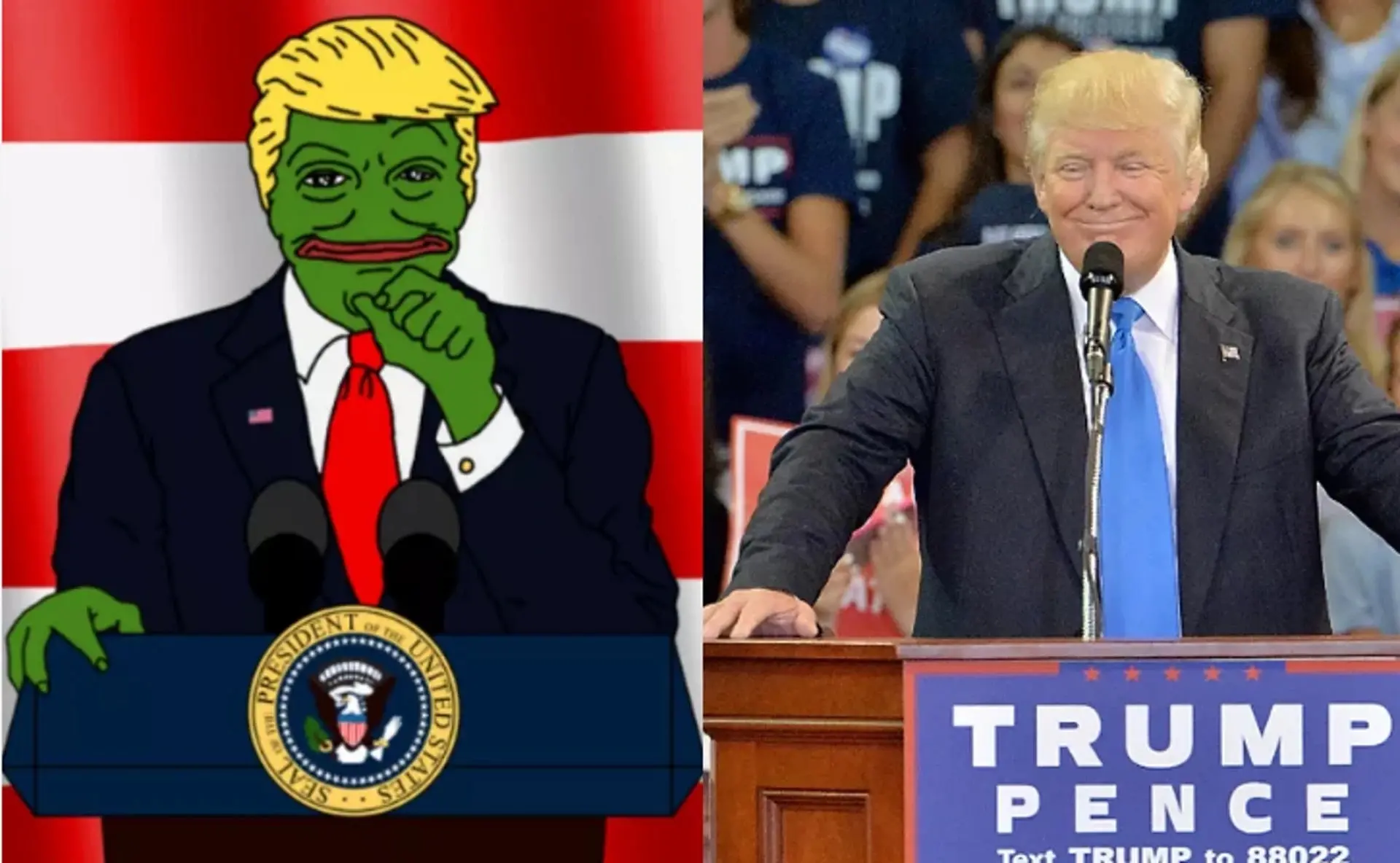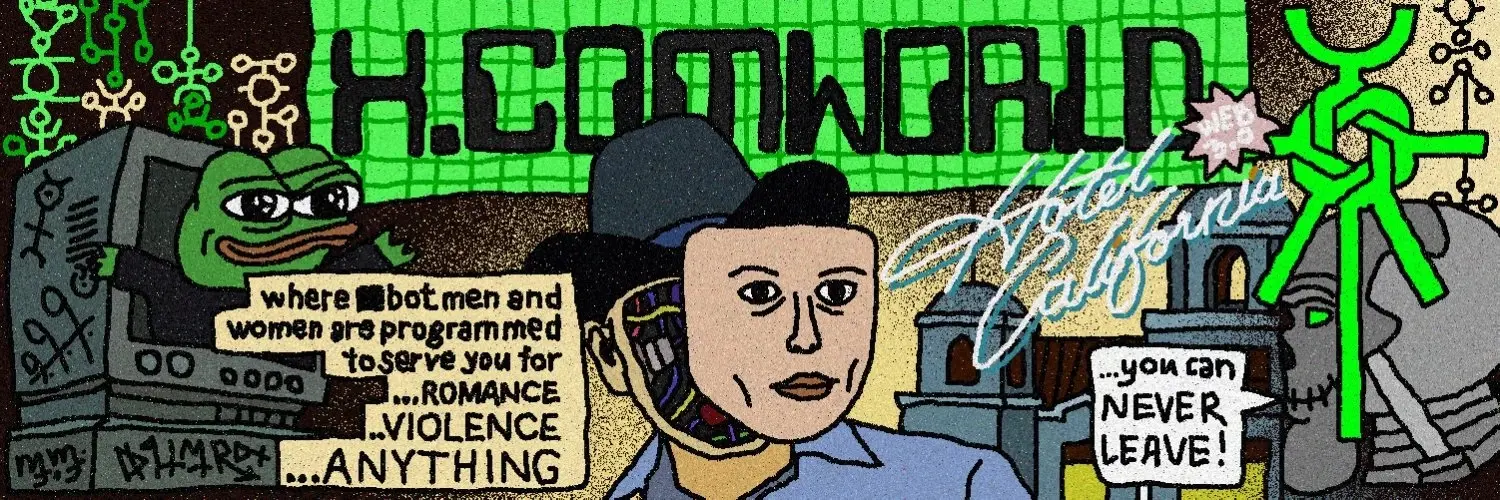Author: Wenser, Odaily Star Daily
Before Trump sold NFTs, there was the Kardashian family patriarch Jenner launching Pump.fun to sell meme coins… The last time celebrities from all walks of life flocked into the cryptocurrency industry was during the boiling craze of NFTs from 2021 to 2022. Now, just like the previous "everything can be NFT" trend, the meme coin craze is expected to take over from NFTs and become a new battleground for countless celebrities, public figures, KOLs, anonymous teams, and others to harvest.
This article provides a brief comparative analysis of meme coins and NFTs for readers' reference.
Analysis of Commonalities: Are Memecoins and NFTs Twin Brothers?
In the article "3-Minute Overview of the Meme Coin History: Past and Future," we mentioned that meme coins originated after Bitcoin as POW coins, with DOGE, born in 2013, generally considered the "first meme coin," even predating the emergence of NFTs. Therefore, based on their similarities, meme coins are the "older brother," and NFTs are the "younger brother." Specifically, the two share commonalities in the following aspects:
Similar Starting Points: From the Community, Back to the Community
The primary commonality between meme coins and NFTs is their community attributes. Whether it's old-school meme coins like DOGE and SHIB, up-and-coming projects like PEPE and WIF, or NFT OG projects like Cryptopunks and BAYC, and NFT head projects exploring IP operations such as Pudgy Penguin, Azuki, and Weirdo Ghost Gang, a strong and united community is essential for the initial stage and subsequent development of a project.
This is one of the reasons why many NFT players who start playing meme coins can quickly integrate, as a good project, whether in terms of community atmosphere or cultural aesthetics, tends to be relatively consistent. Whether it's a shared interest or similar tastes, being able to play together is what forms a community.
Similar Symbols: From the Zoo to Celebrities
The symbols of meme coins and NFTs are also a major commonality. Whether it's animal symbols like dogs, cats, mice, monkeys, frogs, pandas, penguins, or celebrities like Trump, Kanye West, Coinbase CEO Brian Armstrong, Steve Aoki, Snoop Dogg, they are commonly used visual symbols for meme coins and NFT projects. In particular, the combination of Trump and Pepe imagery in meme content has been used as campaign material.
It's no wonder that there were reports of Biden's campaign team planning to hire a meme manager in an attempt to win the support of young voters. After all, memes are a "cultural common denominator" that can resonate, and both meme coins and NFTs can serve as carriers of memes.

Trump & Pepe Meme Content
Similar Entry Barriers: Meme and "Small Pictures"
In terms of entry barriers, meme coins and NFTs also share certain similarities, such as:
1) Both have relatively low understanding costs, one being token-related to memes, and the other being "small pictures"; 2) Both have relatively low purchase thresholds, one being tokens with several zeros after the decimal point, and the other being non-fungible tokens that can be minted for free with only gas fees; 3) Both have relatively simple selling operations, one being sold directly through DEX for on-chain transactions or on exchanges, and the other being traded through different NFT markets.
Of course, the relatively low entry barriers for both are only in comparison to other cryptocurrency fields like DeFi, GameFi, and SocialFi. After all, a wallet can be a barrier for countless Web2 users, leaving them only to sigh at the "airdrops" in the cryptocurrency industry.
Differentiation Breakdown: Are Memecoins More Addictive Than NFTs?
In comparison to their commonalities, the differences between meme coins and NFTs are worth discussing further. For many people, the reason they continue to lose more in the NFT field and see little change after playing meme coins is due to the lack of a clear understanding of the differences between the two, making it easy to fall into the more dangerous "PVP trap" and continue to lose, ultimately having to leave. Specifically, the differences between meme coins and NFTs include:
Liquidity Differences
There's a saying in the industry, "Projects that only talk about floor price/unit price without discussing liquidity are playing rogues." Indeed, the cryptocurrency industry is logically supported by countless liquidity, so it's difficult to find high-quality investment targets in the volatile market by only looking at the single token price of meme coins or the floor price of NFTs.
Moreover, compared to the industry-standard 5K or 10K quantity limits for NFT projects, meme coin projects often have total supplies in the tens of billions or even hundreds of billions, and given that the main player base in the industry is still token players, and the relatively simpler buying and selling operations on DEX, the liquidity differences between the two are significant, mainly reflected in:
1) Initial liquidity. Generally, the initial liquidity of NFTs is much smaller than that of meme coins. For some NFT projects, a few dozen ETH can raise the floor price, while meme coins require higher initial liquidity; 2) Liquidity rate. Generally, the liquidity rate of meme coins is much higher than that of NFTs. If they become the focus in a short period, both liquidity and market value can grow rapidly, while NFTs are limited by the operational functions of NFT trading markets, making it difficult to achieve such rapid price increases; 3) Liquidity cliff. Generally, the liquidity cliff of meme coins is steeper, and in extreme cases, the number of sellers and the amount of tokens sold can rapidly decrease in a matter of minutes or even seconds, which is more terrifying than the "disappearing buy orders" of NFTs.
Therefore, NFT players venturing into the meme coin field should first prioritize an increased focus on project liquidity.
Information Differences
Meme coins and NFT projects also have significant differences in their response to information, mainly due to the different mediums (tokens vs. NFTs) between the two.
For NFT projects, positive news is often categorized as:
1) The project's founding team is a well-known team in the industry; 2) The project has received a huge capital investment; 3) The project has caused a huge sensation or eyeball effect in the Web2 domain, and so on.
Behind these pieces of information lies the NFT players' expectations of "buyers." In other words, NFT players will only FOMO if they see more powerful players entering and able to buy, in an attempt to sell their "small pictures" to "value investors." Therefore, many NFT projects, even if they turn to issuing tokens, will find it difficult to stop the downward trend of the floor price without strong capital intervention.
Meme coins, on the other hand, are completely different. For meme coin projects with stronger community and meme attributes, the entry of capital or institutions often leads to holders rushing to sell. Perhaps it's because meme coins embody more people's expectations of decentralization, or perhaps many people feel that institutional entry is the price peak.
In addition, unlike the "see joy, not sorrow" approach of NFT projects, in many cases, what is commonly considered "bad news" is actually good news for a meme coin project. For example, the Solana ecosystem meme coin project SLERF, after the founder mistakenly destroyed the liquidity pool, actually attracted significant attention from the crypto community. This incident led to the famous meme "Oh, Fuck" and propelled the coin price to break through $1 and quickly list on multiple mainstream exchanges.
In other words, meme coin projects care more about "whether more people are paying attention" rather than "whether this thing is good or bad."
Difference in Virality
Based on these differences and the more viral nature of meme coins compared to NFTs as a cultural medium, the difference in virality between the two is also significant.
A good meme coin can achieve dissemination to hundreds of thousands or even millions of people in just a few days or even hours. In contrast, no matter how hard an NFT project tries, the audience it can reach is limited to a relatively small circle, with only thousands or tens of thousands of people being the impact level that top projects can achieve.
After all, NFT images are limited, while the dissemination of memes is unlimited.
Difference in Opacity
Furthermore, due to the differences in audience scope and distribution methods, meme coins have a stronger sense of opacity than NFTs. After all, NFT's "insider trading" often only occurs through whitelist distribution, with a relatively small number of addresses. In contrast, meme coins have more participating addresses, making insider trading addresses more concealed and the selling methods more diverse.
The flexibility of tokens is far greater than that of NFTs, and this is quite evident.
Investment Strategy Choices
Therefore, based on these differences, the game difficulty for meme coin players is actually higher than that for NFT players. Therefore, the main investment strategies can be divided into three types:
- The first type is luck-based, purely relying on luck. If you happen to buy into a meme coin like Golden Dog and manage to hold without selling, then you deserve to make money.
- The second type is casting a wide net, being patient, especially during the meme coin craze. Investing a small amount in individual projects and eventually achieving a victory through the "horse racing" mechanism, where one or a few projects cover all costs and still yield profits, is also a good way out.
- The third type is tracking-based, suitable for alpha players who "live on-chain" and are sensitive to information. They can snipe early in the meme coin's launch (generally within 1-3 hours), then sell in batches based on the project's development and information, early gaining more chips and then gradually taking profits. This method has the highest difficulty, the greatest returns, and of course, the highest risk.

Darkfarms1 account homepage background image
Analysis of Key Players: The Times Have Changed, but the Players Remain the Same
After discussing what has changed, let's talk about what hasn't changed, namely the main players currently in the field. We can categorize them into three types, as the times have changed, but the players remain the same:
Project Parties
In the past, there were mainly two types of NFT project parties: one was from crypto-native teams, with extensive experience in the cryptocurrency industry, whether from DeFi teams or industry professionals, and a relatively high success rate; the other was teams entering the Web3 field from traditional industries under the influence of the wealth effect, achieving "Web2 upgrade," including star projects, traditional company projects, IP projects, and more.
Compared to the past, meme coin project parties also include these two types of people, but the former group has a slightly higher ratio. This is simply because the survival ability of the crypto-native crowd is stronger, able to survive bear markets and persist through bull markets, and is active in the current "monkey market." Traditional teams have either been eliminated or have quickly integrated, gradually understanding industry rules and norms, and have embarked on their own "harvesting" path.
It's worth mentioning that one of the main forces behind this year's meme coin craze is former crypto artists. BOME, under the efforts of Darkfarms1, became a popular project leading the meme coin craze and achieved the feat of "listing on Binance within 3 days." BOME is a loyal fan and creator of Pepe memes and is also an NFT artist.
Participants
Unlike the relatively homogeneous composition of participants in the NFT race in the past, who may have entered for the sake of art, aesthetics, or collecting, the participants in the meme coin industry today have a more complex composition. There are both wealthy whales, tycoons, and wild speculators, as well as small retail investors chasing dreams, and even young people with aspirations to "improve their lives." Surprisingly, everyone's goals are remarkably consistent and pure: to make money.
Whether it's zero-sum games within the industry or external capital inflows, a meme coin project that makes me money is a good project.
Different Types of Platforms
Unlike the dominance of a few platforms in the past NFT trading market and the situation of "one release, all NFTs disappear," the emergence of meme coins has actually contributed to the continuous development and improvement of different types of platforms. There are aggregation platforms like DEX SCREENER, DEX TOOLS, and BirdEye, as well as robot tools like BananaGun, PepeBoost, Gmgn.ai, and NFT Sniper, which attract countless funds during the meme coin craze through advertising, subscriptions, or fees.
One can only say that opportunities are for those who are prepared, and so is money.

Dex Screener account homepage background image
The Everlasting Theme: Asset Issuance and Wealth Games
As time goes by and the bull and bear markets continue, many things have changed, but only two things remain unchanged:
Asset Issuance: From NFT Component Platforms to "One-Click Token Issuance"
In the past, NFT was a major way for asset issuance, but it had many issues, such as art preparation, contract deployment (different standards like ERC-721, ERC-1155), project operation preparation, pricing strategies, KOL marketing, whitelist mechanisms, gas fees during minting, and more. This led to the emergence of different types of platforms like NFT component platforms, NFT mint platforms (such as mint.fun, Zora, Manifold), and floor-sweeping platforms (like genie). It's no wonder that some people joked that "many NFT projects could have just taken the money and still gave me a small picture."
Now, meme coins have become the hottest track, and whether it's celebrities, artists, stars, L2 networks, or popular ecosystems, they can achieve asset issuance and market attention through meme coins. "One-click token issuance" platforms like Pump.fun have pushed the meme coin craze to the extreme, and the rapid increase in the number of meme coins in the Solana ecosystem is also thanks to this.
This reflects a major long-term trend in the cryptocurrency industry: any model that can achieve rapid asset issuance will become part of the industry.
From the past DeFi Summer, to the GameFi craze, and now to NFT Summer, it's always been like this.
Wealth Games: From Believing in Capital to Not Taking Each Other's Offers
Compared to the past, the landscape of wealth games has undergone significant changes. The development of the cryptocurrency industry in the past often relied on the push of venture capital and cryptocurrency funds. On the one hand, this was due to the need for financial support, as the entry of capital could bring more stable cash flow support. On the other hand, it was due to the impact of capital beyond funding, such as marketing, legal compliance, and endorsements.
However, after the approval of Bitcoin spot ETF in the United States earlier this year, the situation has changed.
In the past, the situation of retail investors taking over from institutions has been rejected by the market, whether it's on L1 public chains, infrastructure construction, L2 networks, or AI, DePIN, RWA tracks. Compared to the "at least seemingly" more decentralized meme coin track, the attractiveness is not as strong as before.
On the one hand, if it's for the consideration of investment portfolio allocation, retail investors can enter the cryptocurrency market through the US stock market and buy Bitcoin spot. On the other hand, if it's for the consideration of earning wealth through high multiples and high-risk games, retail investors are more inclined to invest in meme coins with lower entry barriers, easier understanding, and no so-called "value empowerment and roadmap promises."
It has to be said that this group of retail investors seems to be less easily fooled than before.
Or perhaps, the market environment has indeed changed.
Conclusion: Memecoin may become the "first lesson for crypto newcomers" in the future
At the end of the article, I'd like to conclude with a question.
Many people judge the stage of market sentiment based on the degree of FOMO among off-market crowds. Some people use the inquiry of off-market individuals (especially the elderly) about the timing to buy Bitcoin as a standard, while others use the purchase of meme coins by off-market individuals as an indicator of a market top, and sometimes it's indeed accurate.
But looking at it from a different perspective, when an ordinary person with limited assets enters the cryptocurrency market for the first time, looking at the myriad of tokens, colorful candlestick charts, and different trading buttons on exchanges or DEX, holding a few hundred or a few thousand dollars, will they choose to "play it safe, invest in Bitcoin, Ethereum," or will they choose "meme coins with strong virality, strong emotional resonance, tokens with a single price so low that it can be ignored, and possibly have 10x, 100x, or even 1000x high returns"?
To be honest, I don't have a standard answer, and the answer lies in each person's heart.
免责声明:本文章仅代表作者个人观点,不代表本平台的立场和观点。本文章仅供信息分享,不构成对任何人的任何投资建议。用户与作者之间的任何争议,与本平台无关。如网页中刊载的文章或图片涉及侵权,请提供相关的权利证明和身份证明发送邮件到support@aicoin.com,本平台相关工作人员将会进行核查。




